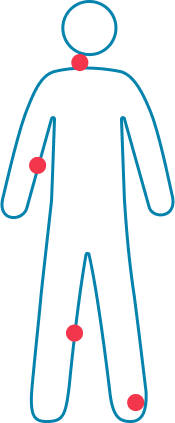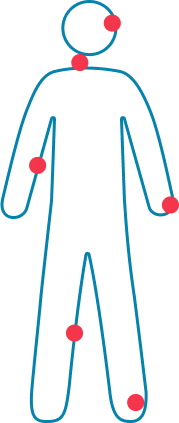Symptoms of eczema
- Dry and cracked skin
- Itchy skin
- Rash on swollen skin
- (red on light-colored skin; dark brown, purple or grey on darker-colored skin)
- Small, raised bumps on brown/black skin
Symptoms of atopic dermatitis
(eczema)
Atopic dermatitis causes areas of the skin to become dry and itchy.1-2 So, how can we identify atopic dermatitis? Common symptoms include1,2:
- Dry and cracked skin
- Itchy skin
- Rash on swollen skin
- (red on light-colored skin; dark brown, purple or grey on darker-colored skin)
- Small, raised bumps on brown/black skin
- Oozing and crusting
- Thickened skin
- Darkening of the skin around the eyes
- Raw, sensitive skin from scratching


Affected skin areas and features
Body parts affected by atopic dermatitis (eczema) and their common features
Symptoms of atopic dermatitis can appear anywhere on the body, and it might appear differently in children and adults.1,3
Infants
(up to 2 years)

Common skin features
-

-


Affected body parts
- Face
- Scalp
- Area of skin around joints that touch when the joint bends
Childhood
(2 years to puberty)

Common skin features
-

-


Affected body parts
- Elbow, usually in the bend
- Knees, usually in the bend
- Neck
- Ankles

Common skin features
-

-


Affected body parts
- Hands
- Neck
- Elbow, usually in the bend
- Knees, usually in the bend
- Skin around the eyes
- Ankles and feet


Signs of infection in eczema
Signs of an infection with atopic dermatitis (eczema)
At times, your inflamed skin may be more likely to get infected with bacteria or virus, especially when your skin has become cracked and broken due to atopic dermatitis.8 There is also a higher chance of infection if you scratch or do not use your treatments correctly.8
Signs of an infection can include4,8:
- Symptoms of atopic dermatitis getting worse and not responding to regular treatments
- Fluid oozing from the skin
- Swollen and sore skin
- Feeling hot and shivery
- Yellow crusts on the skin surface
- Small yellowish-white spots appearing on areas affected by atopic dermatitis
If you think you might have an infection, consult your doctor immediately for timely diagnosis and appropriate treatment.
How is eczema caused?
What causes atopic dermatitis (eczema)?


Irritants
(eg, soap, detergents, wool or synthetic fabrics)
Environmental factors
(eg, cold or dry environments, rapid temperature changes)
Allergens
(eg, pollen, house dust mites, food allergies)

How to treat atopic dermatitis
If you suspect that you might have atopic dermatitis, click to learn more about the treatments and when to seek medical help.
References
- Mayo Clinic. Atopic dermatitis (eczema): Symptoms and causes. Available at: www.mayoclinic.org/diseases-conditions/atopic-dermatitis-eczema/symptoms-causes/syc-20353273. Accessed Oct 2025.
- NHS. Atopic eczema: Overview. Available at: www.nhs.uk/conditions/atopic-eczema/. Accessed Oct 2025.
- National Institute of Arthritis and Musculoskeletal and Skin Diseases. Atopic dermatitis. Available at: www.niams.nih.gov/health-topics/atopic-dermatitis. Accessed Oct 2025.
- NHS. Atopic eczema: Symptoms. Available at: www.nhs.uk/conditions/atopic-eczema/symptoms/. Accessed Oct 2025.
- Gooderham MJ, et al. J Cutan Med Surg 2018;22:3S-5S.
- Harmonising Outcome Measures for Eczema (HOME). How to use EASI (EASI guidance v3 January 17). Available at: www.homeforeczema.org/documents/easi-user-guide-jan-2017-v3.pdf. Accessed Oct 2025.
- European Task Force on Atopic Dermatitis. Dermatology 1993;186:23-31.
- NHS. Atopic eczema: Complications. Available at: www.nhs.uk/conditions/atopic-eczema/complications/. Accessed Oct 2025.
- NHS. Atopic eczema: Causes. Available at: www.nhs.uk/conditions/atopic-eczema/causes/. Accessed Oct 2025.
- UpToDate. Patient education: Eczema (atopic dermatitis) (Beyond the Basics). Available at: www.uptodate.com/contents/eczema-atopic-dermatitis-beyond-the-basics. Accessed Oct 2025.

